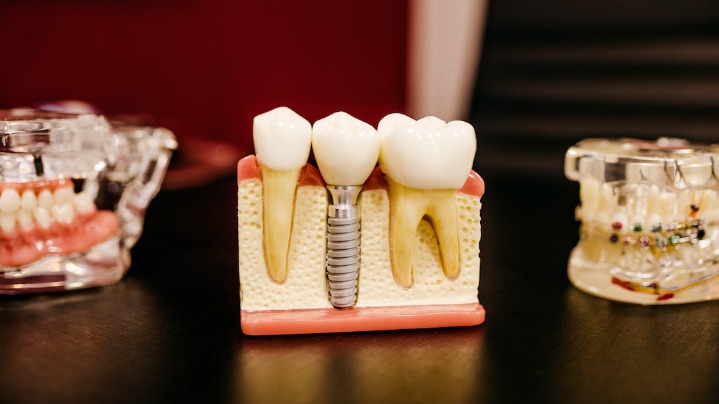
Dental Implants – Replacing Missing Teeth
What Is A Dental Implant?
Contents
A dental implant replaces a single missing tooth or several teeth. It is made up of a titanium screw implanted into the jaw bone, and then a crown is placed on top to make it look like a natural tooth. A crown, or dental cap, is made of porcelain and is like a thimble that sits over the implant to make it look like a real tooth. Several different dental professionals can place an implant, including implantologists, oral and maxillofacial surgeons, periodontists (gum specialists), and some general dentists. The process of having an implant done involves a number of appointments, usually over the span of 3 or more months.
Dental Implants Procedure
Before the dental implant surgery, you will need to be examined by your dentist. If your dentist doesn’t do implants themselves or if your case is more complicated, you may be referred to a periodontist or an oral and maxillofacial surgeon (or simply known as an oral surgeon). You will need to have the appropriate x-rays and possibly a CT scan (like an x-ray but with much more detail) to ensure there is enough bone to place the implant. Your implantologist will also use these scans to look at the location of your sinuses and any other vital structures to ensure there are no unexpected complications with the dental implant procedure.
These x-rays will also indicate whether you require additional procedures, such as a bone graft or sinus lift. A bone graft may be needed if there is not enough bone to place the implant. This is often the case for people who have had their tooth missing for a long time and the bone has shrunk back.
A bone graft replaces the missing bone using your own bone or artificial bone. A sinus lift, also called a sinus augmentation, may be required for people who have upper implants placed very close to where the sinuses are. A sinus lift adds more bone height to make the implant space. Your dentist or specialist may organize these x-rays.
Dental Implant Surgery
This is the process of placing the titanium screw in your jaw. Dental implant surgery is usually a fairly short procedure not generally taking any more than 45 minutes. For more information, go to dental implant procedure.
Fitting Of A Dental Implant Crown
To have a crown made to go on top of your implant will usually require two visits with your dentist. During the first visit, the dentist will take some molds of your implant and surrounding teeth. These molds will be sent away to a laboratory to make the crown, and you will return to your dentist a few weeks later to have the crown permanently screwed into your implant. An x-ray may also be taken to ensure everything is screwed in correctly.
What Fills The Gap While I’m Waiting For My Implant Site To Heal?
This won’t be a concern for people who are having implants done at the back of their mouth. But if your implant is at the front of your mouth, what can you use to fill the gap in the meantime? To avoid placing unnecessary pressure on the implant while it is healing, you may not be able to have a tooth placed directly on your implant. Instead, you could have a partial denture made. This is a plate, usually made of acrylic, which is removable and can replace the missing tooth.
What Is The Dental Implant Failure Rate?
Dental implants are one of the most successful procedures in dentistry, with a success rate of over 90%. Dental implant failure is still possible, and several factors will bring down their success rate. Smoking will drastically increase the risk of failure. Uncontrolled Type 2 diabetes may affect the body’s ability to heal due to decreased blood circulation, which may not make a patient the right candidate to have an implant done.
Dental Implant Pain
During the procedure for the implant, your implantologist will administer a local anesthetic so you should not experience any pain. Some implantologists may give you the option to have the surgery done under general anesthetic (meaning that you’re completely asleep and unaware of the procedure) or with nitrous oxide (commonly known as laughing gas). This may be done for complex cases or patients particularly anxious about the procedure. Although placing an implant is a surgical procedure, any pain you experience afterward should be mild. Paracetamol is generally all required, but your implantologist may recommend something stronger if they think it is required. For subsequent visits to have the crown fitted or any other adjustments to the crown, local anesthetic or other pain relief is not usually required.

